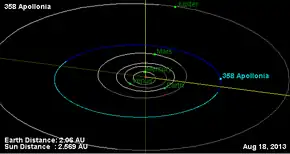 Orbital diagram | |
| Discovery | |
|---|---|
| Discovered by | Auguste Charlois |
| Discovery date | 8 March 1893 |
| Designations | |
| (358) Apollonia | |
| Pronunciation | /æpəˈloʊniə/[1][2] |
Named after | Possibly Apollonia (Illyria)[3] |
| 1893 K | |
| Main belt | |
| Orbital characteristics[4] | |
| Epoch 31 July 2016 (JD 2457600.5) | |
| Uncertainty parameter 0 | |
| Observation arc | 118.08 yr (43129 d) |
| Aphelion | 3.31497 AU (495.912 Gm) |
| Perihelion | 2.43597 AU (364.416 Gm) |
| 2.87547 AU (430.164 Gm) | |
| Eccentricity | 0.15284 |
| 4.88 yr (1781.0 d) | |
| 179.300° | |
| 0° 12m 7.682s / day | |
| Inclination | 3.55411° |
| 172.161° | |
| 253.343° | |
| Physical characteristics | |
| Dimensions | 89.45±2.7 km |
| 50.6 h (2.11 d) | |
| 0.0506±0.003 | |
| 9.1 | |
Apolonia (minor planet designation: 358 Apolonia) is a large Main belt asteroid.[4] It was discovered by Auguste Charlois on 8 March 1893 in Nice.
References
- ↑ Noah Webster (1884) A Practical Dictionary of the English Language
- ↑ "Apollonian". Oxford English Dictionary (Online ed.). Oxford University Press. (Subscription or participating institution membership required.)
- ↑ Schmadel, L. (2003:45). Dictionary of minor planet names. Germany: Springer.
- 1 2 "358 Apollonia (1893 K)". JPL Small-Body Database. NASA/Jet Propulsion Laboratory. Retrieved 11 May 2016.
External links
- 358 Apollonia at AstDyS-2, Asteroids—Dynamic Site
- 358 Apollonia at the JPL Small-Body Database
This article is issued from Wikipedia. The text is licensed under Creative Commons - Attribution - Sharealike. Additional terms may apply for the media files.